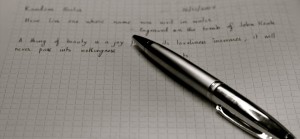While writing an essay, research paper, or report, you may run across a turn-of-phrase that is too perfect not to use word-for-word in your own paper. If you have the perfect line of writing from a source that just begs to be added in to your paper, there are a few steps to ensure you do so successfully.
First and foremost, make sure you know how to properly cite the original source you’re quoting each and every time you take words verbatim and place them in your paper. In all citation styles, quotation marks are necessary to indicate where a direct quote begins and ends. Then, use footnotes or parenthetical citations to indicate where the quote originated.
Citation guidelines for how to properly attribute a quote to a source can be found in The Everyday Writer. The three most common styles of citation are Modern Language Association documentation (MLA), Chicago style documentation or American Psychological Association documentation (APA). Guidelines for how to properly use any one of these three styles begins on page 461 of The Everyday Writer, 6th edition. Another excellent resource is the Online Writing Lab at Purdue University (OWL).
Properly citing a source is not the only struggle writers face in using direct quotes. It is also imperative to consider style when using quotations. Two major pitfalls often capture emerging writers. They’re easy to avoid and will drastically improve writing style if you consider the following two issues.
1) Avoid dropping a quote in to your writing with little to no introduction or integration. This creates a break in the flow for your reader and causes them to disengage or “come out of” the paper they’re reading. Instead, consider using a signal phrase or verb for better flow.
Don’t Do the Following:
Integrating quotes into a paragraph smoothly takes practice. Although some students think it’s ok to drop a quote their writing with little preamble, this makes for clunky and amateurish writing. “Carefully integrate quotations into your text so that they flow smoothly and clearly into the surrounding sentences” (Lunsford et al. 214). That way your quotes will enhance your writing rather than detract from the paper.
Do the Following:
Integrating quotes into a paragraph smoothly takes practice. Although some students think it’s ok to drop a quote their writing with little preamble, this makes for clunky and amateurish writing. According to the writing handbook, The Everyday Writer, it’s important to, “Carefully integrate quotations into your text so that they flow smoothly and clearly into the surrounding sentences.” (Lunsford et al. 214). That way your quotes will enhance your writing rather than detract from the paper.
| Signal Verbs for Quote Integration | |||
| Acknowledges | Advises | Agrees | Allows |
| Answers | Asserts | Believes | Charges |
| Claims | Concludes | Confirms | Criticizes |
| Declares | Describes | Disagrees | Discusses |
| Disputes | Emphasizes | Expresses | Interprets |
| Lists | Objects | Observes | Offers |
| Opposes | Remarks | Replies | Reports |
(Lunsford et al. 184)
Check out page 184 in The Everyday Writer (6th edition) for additional information on using quotations.
2) Avoid ending a paragraph with a quote and no analysis of that quote. This leaves your reader unsure of the significance of a quote. Instead, create strong analysis by directly addressing the significance of a quote each and every time you use one. A good rule of thumb is to reflect back to your thesis statement after each piece of evidence and make sure the connection between thesis and quotation is clear. Explain why that connection is relevant and or important to your paper.
Don’t Do the Following:
Shakespeare ‘s witches in Macbeth are some of the most quoted characters of all time. This is especially true around Halloween. The three witches stand around a cauldron and chant in unison, “Double, Double Toil and Trouble;/ Fire burn and cauldron bubble” (Pechman).
Do the Following:
Shakespeare ‘s witches in Macbeth are some of the most quoted characters of all time. This is especially true around Halloween. The three witches stand around a cauldron and chant in unison, “Double, double toil and trouble;/ Fire burn and cauldron bubble” (Pechman). This brings to mind three hags standing around a smoking, bubbling pot stirring up trouble for Macbeth. He certainly doesn’t need any more trouble on his side, but the witches’ song foreshadows for the audience that life is about to become a hell on earth for Macbeth.
Works Cited
Lunsford, Andrea A., Paul Kei. Matsuda, and Christine M. Tardy. The Everyday Writer. Boston: Bedford/St. Martin’s, 2016. Print.

